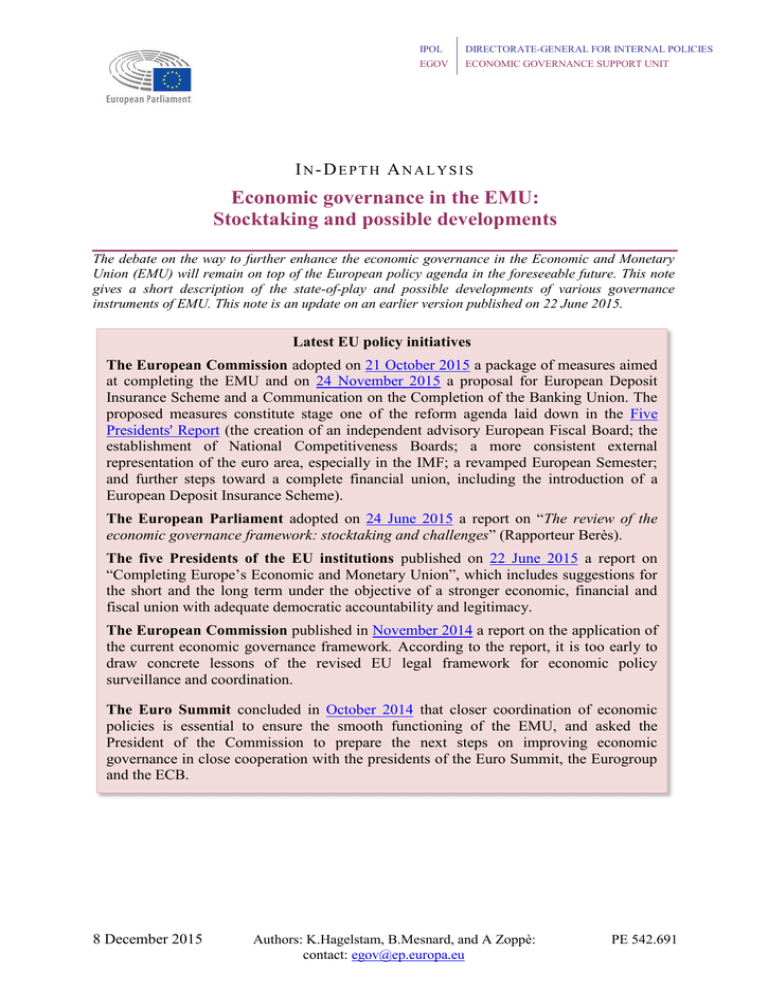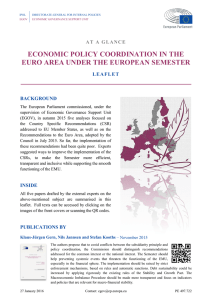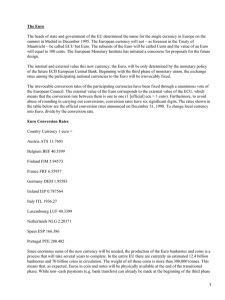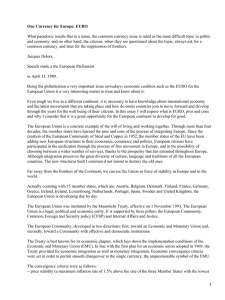Economic governance in the EMU: Stocktaking and possible
Anuncio

IPOL DIRECTORATE-GENERAL FOR INTERNAL POLICIES EGOV ECONOMIC GOVERNANCE SUPPORT UNIT IN-DEPTH ANALYSIS Economic governance in the EMU: Stocktaking and possible developments The debate on the way to further enhance the economic governance in the Economic and Monetary Union (EMU) will remain on top of the European policy agenda in the foreseeable future. This note gives a short description of the state-of-play and possible developments of various governance instruments of EMU. This note is an update on an earlier version published on 22 June 2015. Latest EU policy initiatives The European Commission adopted on 21 October 2015 a package of measures aimed at completing the EMU and on 24 November 2015 a proposal for European Deposit Insurance Scheme and a Communication on the Completion of the Banking Union. The proposed measures constitute stage one of the reform agenda laid down in the Five Presidents' Report (the creation of an independent advisory European Fiscal Board; the establishment of National Competitiveness Boards; a more consistent external representation of the euro area, especially in the IMF; a revamped European Semester; and further steps toward a complete financial union, including the introduction of a European Deposit Insurance Scheme). The European Parliament adopted on 24 June 2015 a report on “The review of the economic governance framework: stocktaking and challenges” (Rapporteur Berès). The five Presidents of the EU institutions published on 22 June 2015 a report on “Completing Europe’s Economic and Monetary Union”, which includes suggestions for the short and the long term under the objective of a stronger economic, financial and fiscal union with adequate democratic accountability and legitimacy. The European Commission published in November 2014 a report on the application of the current economic governance framework. According to the report, it is too early to draw concrete lessons of the revised EU legal framework for economic policy surveillance and coordination. The Euro Summit concluded in October 2014 that closer coordination of economic policies is essential to ensure the smooth functioning of the EMU, and asked the President of the Commission to prepare the next steps on improving economic governance in close cooperation with the presidents of the Euro Summit, the Eurogroup and the ECB. 8 December 2015 Authors: K.Hagelstam, B.Mesnard, and A Zoppè: contact: egov@ep.europa.eu PE 542.691 Current governance tools Today the governance of the Economic and Monetary Union (EMU) is based on the following main policy tools: A single monetary policy for the euro conducted by the European Central Bank and based on the Treaties; common fiscal rules based on the Treaties, and their specifications in secondary law; Member States’ responsibility for their fiscal and economic policies through the Treaty-based “no bail-out principle”; multilateral surveillance of national economic policies, including macro-economic imbalances, based on the Treaties, and its specification in secondary law; enhanced surveillance mechanisms and the possibility to grant Member States financial assistance under strict conditions in order to safeguard the stability of the euro, based on international agreements, the Treaties and specifications in secondary law; and a Banking Union based on the Treaties, international agreements, and its specification in secondary law. In addition, a well-functioning single market, including progress to a capital markets union, is an important component of the EMU. As regards banking supervision and banking resolution, some competences have recently been moved from national level to the EU level, in particular for euro area Member States that take part in the Single Supervisory Mechanism (SSM) and the Single Resolution Mechanism (SRM). In order to deal with (a)symmetric shocks in Member States of the euro area, the EU framework relies on the capacity of national budgetary policies to react to adverse economic environments under certain restrictions. In particular, a number of detailed fiscal rules (regarding public deficits and public debt limits) have been introduced at the EU level with the aim to safeguard that Member States may continue to enjoy national fiscal capacity over the economic cycle, and to prevent the implementation of unsustainable fiscal policies. However, this rule-based system and soft-coordination approach has proved to be insufficient in preventing the build-up of major economic and fiscal imbalances that triggered the euro area crisis in 2010-2012. Since then, several tools have been created or reviewed to restore the credibility of the euro area financial architecture. On the one hand, to safeguard the stability of the euro, financial assistance has been granted to Member States in difficulty, as a last resort measure and subject to macroeconomic adjustment programmes. Different financial instruments were created to that end, which ensured a higher level of risk sharing among Member States. On the other hand, the surveillance and coordination of economic policies has been significantly strengthened. Current tools have been revised and new tools have been introduced in EU legislation (“six pack” and “two pack”). These economic governance tools are implemented as part of a policy cycle in the form of the European Semester for economic policy coordination, with the aim of guaranteeing the coherence of the economic and fiscal policy recommendations adopted at Union level. This is, in particular, the case when country-specific policy recommendations are addressed each year by the Council to the Member States and the euro area as a whole. Finally the setting up of a Banking Union to supervise banks in good times, and to handle their resolution in bad times, aims at breaking the negative feedback loop between failing banks and weak sovereigns, thereby enhancing the credibility of the overall architecture. PE 542.691 2 EU Treaty provisions framing national economic policies – The Member States shall coordinate their economic policies within the Union. To this end, the Council shall adopt measures, in particular broad guidelines for these policies. Specific provisions shall apply to those Member States whose currency is the euro. The Union shall take measures to ensure coordination of the employment policies of the Member States, in particular by defining guidelines for these policies. The Union may take initiatives to ensure coordination of Member States' social policies (Article 5 TFEU). – Member States shall conduct their economic policies with a view to contributing to the achievement of the objectives of the Union (Article 120 TFEU) and, hence, shall regard their economic policies as a matter of common concern and shall coordinate them within the Council [...] (Article 121(1) TFEU); Member States shall avoid excessive government deficits (Article 126(1) TFEU). – The Union shall not be liable for or assume the commitments of central governments, regional, local or other public authorities, other bodies governed by public law, or public undertakings of any Member State, without prejudice to mutual financial guarantees for the joint execution of a specific project. A Member State shall not be liable for or assume the commitments of central governments, regional, local or other public authorities, other bodies governed by public law, or public undertakings of another Member State, without prejudice to mutual financial guarantees for the joint execution of a specific project (Article 125 TFEU). – In order to ensure the proper functioning of economic and monetary union, and in accordance with the relevant provisions of the Treaties, the Council shall […] adopt measures specific to those Member States whose currency is the euro: (a) to strengthen the coordination and surveillance of their budgetary discipline; (b) to set out economic policy guidelines for them, while ensuring that they are compatible with those adopted for the whole of the Union and are kept under surveillance (Article 136(1) TFEU). The EU framing elements share a common set of objectives, the main purpose of which is to prevent and correct unsustainable economic policies, and, in more general terms, support sustainable growth and job creation in EU's Member States. Debate about future tools Concerning the debate on the future governance structure of EMU, proposals usually promote one of the following (not necessarily exclusive) approaches: a. Improve the coordination of economic policies through the EU rule-based surveillance system; b. enhance micro- and macro-prudential supervision and strengthen the regulatory framework in order to better manage financial risks within the EMU; c. increase the level of mutualisation of risks and resources, through common tools or policies, which also reduces instability and associated risks within the EMU; d. restore the responsibility of the Member States over their public finances in order to enhance market discipline. Those approaches may include the following elements: a. Improving the current “EU rule-based surveillance system" can be done without legal modifications, for instance by improving the underlying analytical framework and the policy recommendations, or by strengthening enforcement and commitment to 3 PE 542.691 current procedure at EU and national level. Making the framework more/less strict or more/less comprehensive may also entail legal modifications. b. Risk reduction can be achieved through a common supervision and regulation of the banking sector. In particular, the underlying regulatory framework (“Single Rulebook") is crucial in this regard. While the Single Supervisory Mechanism is tackling the issue of options and discretions in the hands of supervisors, a number of national options and discretions remain in the hands of the legislator.. c. Increasing the level of mutualisation through risk-sharing or (temporary/structural) transfers of resources may require changes to the current “competences between national and EU level”, i.e. by changes to primary law (EU Treaties and/or intergovernmental agreements) in order to establish new EU and/or national tools. Such tools would likely require stronger institutions at the EU and/or national level. Risk-sharing may be introduced in many ways. One example is the proposal for a European Deposit Insurance Scheme, which would in the end rely on a Single Deposit Insurance Fund. Another example is the proposal to create a common treasury at EU level, or to issue a limited amount of Eurobonds or Treasurybills. Such instruments should also contribute to the reduction of financial risks within the euro area by limiting the risk of contagion of financial instability from one Member State to another, or the risk of negative self-fulfilling prophecies that can undermine the financial position of otherwise sound institutions (bank runs). d. Another avenue is to aim for re-establishing “market discipline” by making the "no bail-out rule" ex ante and ex post credible. This may require the creation of a common mechanism allowing Member States to default on part of their bonds (beyond the introduction of collective action clauses), and it may also entail the introduction of appropriate regulatory risk weights or exposure limits for sovereign holdings. However, today the views among politicians and academics vary widely about the optimal way to improve the governance framework of the EMU. In the longer term a solution that would combine further risk sharing and better risk allocation (among and between the public and private sectors) would seem to be the way to satisfy the various interests and objectives. Optimally, the various building blocks for stronger governance in the EMU should serve to establish a framework that gives the correct incentives for the Member States to pursue sustainable economic and social policies over the economic and political cycles. Summary overviews of the state-of-play of various governance instruments of EMU are presented below divided into the following chapters: Banking Union, Budgetary Surveillance, Surveillance of macroeconomic imbalances, European Semester for economic policy coordination and financial stability of the euro. These overviews focus on the governance tools available within the current framework and outline some possible future developments, based mainly on elements included in the Commission blueprint for a genuine EMU, the 2012 four-president report ‘Towards a genuine EMU’, the five EU presidents’ report on completing the EMU, EP Parliament's resolution of 24 June 2015, and the latest Commission proposals mentioned above. PE 542.691 4 Banking Union Legal basis Articles 127(6) (“specific tasks to ECB”) and 114 (“functioning of internal market”) of the TFEU the SSM and SRM Regulations, the Bank Recovery and Resolution Directive (BRRD), and the intergovernmental agreement on the transfer and mutualisation of contributions to the SRF Background: The financial crisis demonstrated that the supervision of banks had to be overhauled. First, the Single Rulebook (a comprehensive set of regulations, directives and technical standards) was strengthened and three European Supervisory Authorities (ESA) as well as an EU wide macro-prudential body (the European Systemic Risk Board) were established. Since then, the Banking Union has seen considerable progress within a very short time frame, with the establishment of the Single Supervisory Mechanism and Single Resolution Mechanism. Single Supervisory Mechanism (SSM): The SSM comprises the European Central Bank and national competent authorities in the participating EU Member States. Within the SSM the Single Supervisory Board (SSB) is responsible, together with national supervisory authorities, for the supervision of financial institutions within the Banking Union. On 4 November 2014 the SSM took direct responsibility for the supervision of the most significant banks. The objective of the board is to ensure that the supervision of banks becomes more independent, better harmonized, and more efficient. Single Resolution Mechanism (SRM): The SRM includes the Single Resolution Board (SRB) and the national resolution authorities. If a bank fails or is at risk of failing, the SRM shall come into play and ensure its orderly resolution, with minimal costs for taxpayers and the real economy. One of its main tasks is to take a forward-looking perspective and ensure that banks have drawn up credible resolution plans that can actually be implemented in times of need. The top level management has been appointed and the staff is being recruited. By 1 January 2016, when the SRB will become the competent resolution authority for significant banks, the SRM will be fully operational. Role of the European Parliament: o Co-legislator on the SRM Regulation; o approval of the appointment of the Chairs and Vice-Chairs of the SSB and of the SRB, and of other SRB full-time members; o may request information to the SSM; o may organise public hearings as well as ad-hoc and confidential meetings with the SSB and the SRB based on inter-institutional or other agreements. Possible future developments Short term: Implementation of agreed legislation (the BRRD, the DGS Directive) at national level; completing the funding (including bridge financing) of the Single Resolution Fund; establishing a European Deposit Insurance Scheme; Further harmonisation of the Single Rulebook (phasing-out national discretion); enhancing macro-prudential oversight in the Banking Union. Medium term and long term: Participation of non-euro zone countries in the SSM and SRM; limiting the bank-sovereign loop and completing the Capital Market Union; establishing a fiscal backstop for the Banking Union. 5 PE 542.691 European Semester for economic policy coordination Legal basis Articles 121 (broad economic policy guidelines), 146 (employment guidelines) and 136 (“euro area specific measures”) of the TFEU Background Before the crisis, budgetary, labour and other economic policy planning occurred along separate and different processes. In the framework of the European Semester, introduced in 2010, budgetary, macro-economic and structural policies are coordinated, analysed and assessed so that Member States can take EU considerations into account at an early stage of their national budgetary processes and in other aspects of economic policymaking. Semester cycle The European Semester for economic policy coordination is aimed at guaranteeing coherence of the recommended policies in particular when country-specific policy recommendations are adopted each year, addressed to the Member States and to the euro area as a whole. Drawing on the experience of the past cycles, the implementation of CSRs varies among Member States. Role of the European Parliament o Co-legislator for the main underlying procedures; o may invite other EU institutions to Economic Dialogues; o may co-operate with national parliaments (e.g. European Parliamentary Week); o may adopt resolutions on the priorities on the implementation of the Semester; o may issue opinions on the annual Employment Guidelines (EG) and resolutions on the Broad Economic Policy Guidelines (BEPG), when appropriate. Possible future developments Short term: Simplifying reporting requirements and granting Member States more time for feedback; strengthening both the multilateral nature of the Semester and the euro area dimension); enhancing the social dimension of EMU, including activating a social and employment scoreboard; better implementation and increased ownership of the CSRs, through macro-economic conditionality applied to the use of the European Structural and Investment funds and through technical assistance to Member States; Greater focus of CSRs on key reforms based on underlying assessment and procedures (SGP, MIP, BEPG, EG); establishing an inter-institutional agreement on the operation of the Semester at EU-level; introducing a more specific link between the Europe 2020 strategy and the European Semester. Medium and long term: Transformation of the BEPG and EGs into EU’s multiannual programme agreed with Parliament and the Council; management of aggregate demand through the cycle with additional fiscal capacity; introduction of more binding convergence guidelines for economic policies; stronger link between CSRs and EU budget or any new grants (euro area). PE 542.691 6 Budgetary surveillance Legal basis Articles 121 ("multilateral surveillance"), 126 ("excessive deficit procedure") and136 ("euro area specific measures") of the TFEU Protocols No 12 and 13 of the TFEU the intergovernmental Treaty on Stability, Coordination and Governance in the EMU (TSCG) Background The sovereign debt crisis in the euro area highlighted not only the weaknesses in many EU countries' budget positions but also some gaps in the Stability and Growth Pact (SGP) that had not been addressed sufficiently in the course of the 2005 reforms. The secondary law implementing the SGP was therefore revised in 2011 (as part of the so-called “six-pack”). In March 2013, the SGP was complemented (as part of the so-called "two-pack") by additional reporting and surveillance of draft budgetary plans for euro area Member States. Preventive arm of the SGP The goal of the preventive arm is to ensure sound public finances by multilateral surveillance. Its key concept is a medium-term sound fiscal position, called medium-term budgetary objective (MTO). Euro area Member States indicate in their Stability Programmes the way they intend to reach their MTOs, and the country-specific adjustment paths are adopted by the Council (as part of the Country Specific Recommendations) based on Commission proposals. The current SGP rules also include an expenditure benchmark, according to which the growth of public expenditure (net of discretionary revenue measures) must be lower than the medium-term potential GDP growth. The aim is to complement the assessment, based on the structural balance, of the progress made towards or in maintaining the MTO. Major deviations from the adjustment path to MTO can lead to warning or sanction, if no appropriate correction measures are taken. Corrective arm of the SGP The corrective arm of the SGP refers to the implementation of the excessive deficit procedure (EDP). The EDP is triggered when the public deficit breaches the 3 % GDP threshold or when the public debt of a Member State is above 60 % of GDP and is not diminishing at a sufficiently rapid pace, as defined by the debt-reduction benchmark, which stipulates that the distance to the 60 % threshold should be reduced by 5 % on average per year (over the past three years or in the next two years). In the event of non-compliance, the EDP foresees sanctions. On 13 January 2015 the Commission published a communication that outlines how "flexibility" may be used within the existing rules of the SGP. The Council is in the process of revising the Code of Conduct pertaining to the SGP. Fiscal compact The main element of the intergovernmental Treaty on Stability, Coordination and Governance in the EMU (TSCG), signed in March 2012 by all Member States (except the United Kingdom, the Czech Republic, and the Republic of Croatia), is a balanced budget rule that must be incorporated into national law. Member States may be brought by other Member States before the European Court of Justice if the rule is not properly implemented. National fiscal institutions All Member States (except the United Kingdom) are required to have in place independent bodies that produce or endorse national medium-term fiscal plans and draft budgets, as well as their underpinning macroeconomic forecasts. These bodies are to be endowed with functional autonomy vis-à-vis the budgetary authorities of the respective Member States, and are to monitor compliance with country-specific numerical fiscal rules. 7 PE 542.691 Draft budgetary plans To ensure the coordination of fiscal policies, Regulation EU) No 473/2013 introduced common budgetary timelines for all euro area Member States as well as rules on the Commission’s assessment of Member States’ draft budget plans. In the event of serious noncompliance with the SGP, the Commission may request that the plans be revised. Role of the European Parliament o Co-legislator; o may invite other EU institutions to an Economic Dialogue; o may invite Member States under the EDP to an Economic Dialogue. Possible future development Short term: Enhancement of discussions on an euro area-wide aggregate fiscal stance, through a revamped European Semester; establishment of an independent advisory European Fiscal Board; Effective enforcement of the rules (imposition of sanctions in the event of noncompliance, and/or application of flexibility of the rules in an objective and credible manner over the economic cycle); possible methodological improvements of the complex concepts (notably of the potential output underpinning the concepts of output gap and structural balance); the review clause of the ‘six’ and ‘two’ packs" could potentially lead to amendments (the Commission did not propose any changes in the review it published at the end of 2014). Medium and long term: Granting the right to the Commission to require a revision of individual decisions of budget execution; competence for the EU to harmonise national budgetary laws; stronger risk-weighting of sovereign debt in banking regulation and central banking rules; stronger fiscal capacity (counter-cyclical buffer for the euro area) at EU and/or national level. PE 542.691 8 Surveillance of macroeconomic imbalances Legal basis Article 3 of the TEU Articles 121(3) (“multilateral surveillance") and 136 (“euro are specific measures”) of the TFEU Background Over the past decade, several Member States have experienced major macroeconomic imbalances. In order to identify and correct such imbalances, including those with potential spill-over effects, a new surveillance and enforcement procedure, the Macroeconomic Imbalance Procedure (MIP) was created at the end of 2011. This surveillance mechanism is integrated in the European Semester. Preventive arm Under the preventive arm of the MIP, the Commission and the Council adopt recommendations in line with article 121(4) of the Treaty. These recommendations are part of the so-called country-specific recommendations (CSRs) that the Commission proposes in May/June within the framework of the European Semester. Corrective arm In severe cases, the corrective arm of the MIP is used. An Excessive Imbalance Procedure (EIP) may be opened for a Member State that, according to MIP regulation, has excessive imbalances. Surveillance will be stepped up by the Commission on the basis of a corrective action plan submitted by the Member State concerned. The lack of implementation of the plan can lead to sanctions for euro area Member States. Although the Commission has identified excessive imbalances in several Member States in the past years, so far it has not proposed the opening of any EIPs. Role of the EP o Co-legislator; o is consulted informally on any modification of the scoreboard used to identify imbalances; o may invite other EU institutions, and representative of Member States under the EIP to an Economic Dialogue. Possible future developments Short term: Introduction of National Competiveness Boards within the euro area, as recommended by the Commission; Effective enforcement/implementation/ownership of the MIP; strengthening the link between the SGP and the MIP regarding structural reforms. Medium and long term: Facilitation of the implementation of structural reforms, based on a system of contractual arrangements and financial instruments, possibly with further fiscal capacity. 9 PE 542.691 Financial stability of the euro Legal basis Articles 121(3) (“multilateral surveillance”), 123(1) (“no monetary financing”), 125(1) (“no bailout”), 136 (“specific measures of the euro area” + “stability mechanism”) of the TFEU ESM Treaty Background The sovereign debt crisis in the euro area generated the need for financial assistance towards Member State facing financial distress. Financial assistance instruments based on strict conditionality were created to ensure the financial stability of the euro area. European Stability Mechanism (ESM) The ESM is a permanent, inter-governmental mechanism, which main objective is to provide, through a number of financial assistance instruments, loans to Member States whose access to market financing is impaired or is at risk of being impaired. Granting of financial assistance to a Member State under the ESM is conditional on the ratification of the TSCG Treaty (Fiscal Compact). EU surveillance framework Regulation (EU) No 472/2013 introduced the possibility for the Commission to decide to subject a Member State to enhanced surveillance if it is experiencing or threatened with serious difficulties with respect to its financial stability that could have adverse spill-over effects on other Member States in the euro area. Furthermore, a Member State requesting financial assistance has to prepare – in agreement with the Commission, acting in liaison with the ECB and, where appropriate, with the IMF – a macroeconomic adjustment programme. Role of the European Parliament o May invite the other concerned EU institutions, in particular the Commission and the Council, as well as a Member State under certain conditions to an Economic Dialogue; o receives reports from the Commission as regards the implementation of adjustment programmes. Possible future developments Short term: Strengthening of macro-prudential tools and institutions, such as the work of the ESRB. Long term: Transformation of the ESM into an EU institution with appropriate fiscal backstop; introduction of elements facilitating the restructuring of sovereign debts; improvement of the external representation of the euro area in international fora and the IMF. DISCLAIMER: This document is drafted by the Economic Governance Support Unit (EGOV) of the European Parliament based on publicly available information and is provided for information purposes only. The opinions expressed in this document are the sole responsibility of the authors and do not necessarily represent the official position of the European Parliament. Reproduction and translation for noncommercial purposes are authorised, provided the source is acknowledged and the publisher is given prior notice and sent a copy. © European Union, 2015 PE 542.691 10 PE 542.691 11





